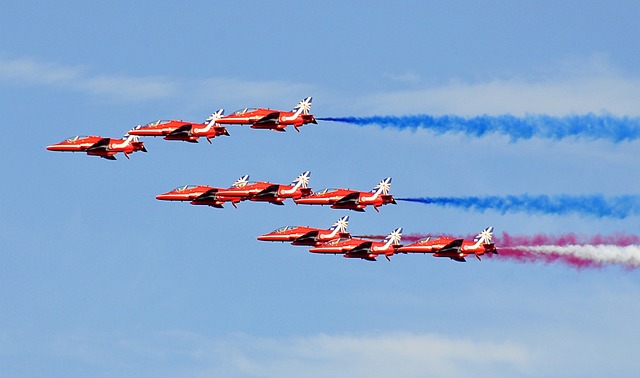The Red Arrows, officially known as the Royal Air Force Aerobatic Team, represent the pinnacle of precision flying and the enduring spirit of the Royal Air Force (RAF). Formed in late 1964, the Red Arrows have become one of the world’s most famous aerobatic display teams, captivating millions with their breathtaking performances. This article delves into the rich history, evolution, and enduring legacy of the Red Arrows.
Formation and Early Years (1964-1970)
In 1964, the Red Arrows were established at RAF Fairford in Gloucestershire, England. The creation of the team aimed to consolidate several smaller RAF display units into one premier squadron. The initial team comprised seven pilots flying the Folland Gnat, a small yet agile jet trainer that quickly demonstrated the team’s potential. In 1965, the Red Arrows performed their first public display at Little Rissington, introducing audiences to their dynamic and precise flying style.
The team’s popularity soared, and by the late 1960s, the Red Arrows had expanded to nine aircraft, enabling them to perform the iconic “Diamond Nine” formation. This formation, along with their intricate aerobatic maneuvers, became the hallmark of their displays. Although the Gnat was praised for its agility, it was eventually considered too small for the team’s expanding visibility and performance requirements.
Transition to the Hawk and Increased Prestige (1970-1980)
By 1979, the Red Arrows transitioned to the BAE Hawk T1, a more powerful and versatile aircraft that remains in use today. The Hawk provided the team with greater capabilities, allowing for more complex and visually stunning maneuvers. In 1980, the team moved to their current base at RAF Scampton in Lincolnshire, which offered improved facilities and support for their growing operations.
International Fame and Operational Challenges (1980-2000)
Throughout the 1980s, the Red Arrows gained international acclaim, performing in numerous countries, including the United States, Canada, and Australia. Their displays became synonymous with precision, teamwork, and the excellence of the RAF. However, the team also faced significant challenges. In 1993, a tragic mid-air collision during a practice session resulted in the loss of two pilots. Despite this heartbreaking incident, the team continued to train rigorously, maintaining their commitment to safety and excellence.
The 1990s saw the Red Arrows celebrating their 30th anniversary. They continued to be a symbol of British aviation prowess, participating in major events and commemorations. The team’s dedication to showcasing the skill and professionalism of the RAF never wavered, even in the face of adversity.
Modern Era and Continuing Legacy (2000-Present)
In the 2000s, the Red Arrows embraced new technologies and refined their display routines, ensuring they remained at the forefront of aerobatic excellence. The advent of social media allowed the team to engage with a global audience, further cementing their status as a leading aerobatic team.
The 2010s were marked by significant tours, including visits to North America and Asia, which solidified the Red Arrows’ international reputation. In 2012, the team played a prominent role in the opening ceremony of the London Olympics, showcasing their skills to a global audience. In 2018, the Red Arrows celebrated the centenary of the RAF with special displays and events, honoring the rich heritage and future potential of British aviation.
Notable Achievements and Contributions
Public Engagement: The Red Arrows have been instrumental in promoting the RAF and inspiring future generations of pilots and aviation enthusiasts. Their displays are a testament to the skill and dedication of the pilots and support crew.
Aviation Excellence: The Red Arrows’ performances demonstrate the highest levels of precision flying, teamwork, and innovation, setting the standard for aerobatic teams worldwide. Their commitment to excellence has earned them a place in the hearts of aviation fans across the globe.
Diplomatic and Cultural Impact: Through their international tours, the Red Arrows have fostered goodwill and strengthened relationships between the UK and other nations. Their displays serve not only as a demonstration of aviation prowess but also as a symbol of international friendship and cooperation.
Conclusion
The Red Arrows remain a vital part of the RAF and a cherished symbol of British aviation. Their commitment to excellence, thrilling displays, and ability to inspire audiences worldwide ensure that their legacy endures for future generations. As they continue to push the boundaries of aerobatic performance, the Red Arrows embody the spirit of precision, teamwork, and dedication that defines the Royal Air Force.
